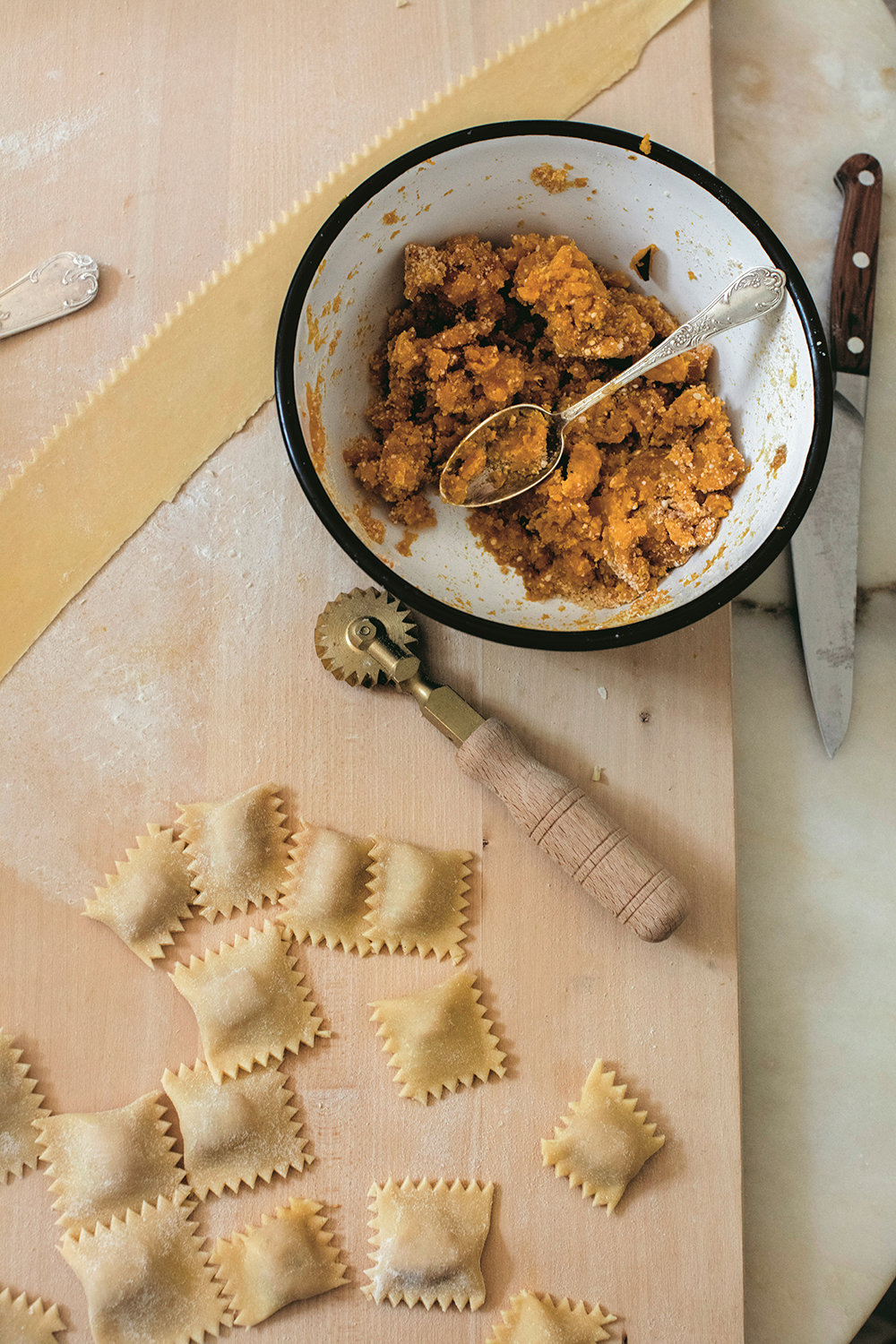Features
How-To: Have a Romantic Date Night without Leaving Home
Chef Mimi Thorisson helps couples bring Italy home with them—in the form of delicious pasta, of course.

No matter how long you’ve been with your partner, one thing is certain: date night is essential. You need time to focus on one another and drown out the chaos of everyday life. But when it’s impossible to leave the house—for whatever reason—Mimi Thorisson, chef and author of cookbooks like Old World Italian, suggests bringing a night out, in. Here are her tips for making it feel like you’re dining on the Amalfi Coast instead of in your own kitchen.
For a fabulous date night, channel the feeling of a romantic Italian vacation from the comfort of your own home. Food can transport you anywhere in the world, and the simple effort of creating a meal for someone you love can be a wonderful way to reignite your passion. So, feed the kids early, let them have a movie night, and then travel to Italy through delicious food and drink. Saluti!



- Set the Mood: Put on a nice playlist that lets you tune out everything else — let it help you get out of parenting and work mode and into a romantic mindset.
- Serve Those Drinks: Create a whole experience as if you were out at a trattoria and ease into your night with a fun Italian-style cocktail. Mix up a Red Wine Spritz—in an ice-filled tumbler, combine two parts Barbera d’Asti or another medium-bodied red wine, one part Campari, top with a dash of Italian citrus soda and garnish with an orange slice.
- Start With Nibbles: Create a charcuterie board with little Italian sausages, hams, and cheeses to nosh on while you sip your cocktails.
- Stay Out of the Kitchen (as Much as Possible): If it’s date night, you don’t want to be working away in the kitchen, so grab a prepared pasta like a ricotta cheese ravioli and whip up an easy butter and sage sauce. I always like to make a simple Cacio e Pepe for my husband because it reminds us of time spent together in Rome. See my recipe below!
- Satisfy Your Sweet Tooth: Prepare a Panna Cotta in advance and top with a caramel sauce or a raspberry coulis. You could share…or each have your own!
Prampolini – Red Wine Spritz
Serves 1 or many
- Ice cubes
- 2 parts Barbera d’Asti or other medium-bodied red wine
- 1 part Campari
- 1 part Italian citrus soda (such as Cedrata)
- 1 orange slice, for garnish
In an ice-filled tumbler, combine the wine and Campari. Add the soda. Garnish with a slice of orange. Serve immediately.
Cacio e Pepe
Serves 4 to 6
- 2 tablespoons black peppercorns
- 1 pound / 500 g dried tonnarelli or spaghettoni (thick spaghetti)
- 3 cups / 270 g finely grated pecorino romano cheese
In a large, heavy skillet, roast the peppercorns over high heat until you hear a popping sound, 4 to 5 minutes. Remove from the pan and grind them with a mortar and pestle or spice grinder. Return the ground pepper to the skillet.
Meanwhile, bring a large pot of salted water to a boil over medium-high heat. Add the pasta to the boiling water and undercook by 5 minutes.
Reserving 1½ cups / 370 ml pasta water, drain the pasta. Add 1 cup / 250 ml of the reserved water to the pan with the pepper. Bring to a simmer over medium heat. Add the pasta to the skillet to finish cooking.
When the pasta is al dente, remove the pan from the heat and stir in the pecorino and remaining ½ cup / 120 ml pasta water. Quickly and vigorously toss the pasta with the sauce to make sure each strand of pasta is coated and the sauce is evenly emulsified. Serve immediately.
Pumpkin Ravioli with Brown Butter, Chestnut, and Sage
Serves 6
Filling
- 1 small pumpkin (1 pound / 450 g)
- Extra-virgin olive oil
- Fine sea salt
- A few sprigs of fresh rosemary
- ⅔ cup / 60 g grated parmesan cheese, plus more for serving
- ½ teaspoon grated nutmeg
- ½ cup / 75 g plain dried bread crumbs
- Freshly ground black pepper
Basic Egg Pasta (recipe follows)
- Rice flour, for dusting
Sauce
- 10 tablespoons / 150 g salted butter, cut into cubes
- 15 fresh sage leaves
- 15 chestnuts, cooked, peeled, and coarsely chopped
Make the filling: Preheat the oven to 400°F / 200°C.
With a sharp chef’s knife, cut the pumpkin into vertical slices 1 inch / 2.5 cm thick. Using a large metal spoon, scoop out the seeds and insides of the pumpkin and discard.
Arrange the pumpkin slices on a baking sheet. Drizzle with olive oil and rub on both sides of the pumpkin. Season all over with salt, toss with rosemary sprigs, and drizzle with more olive oil. Roast until fork-tender, about 20 minutes. When cool enough to handle, scoop the flesh of the pumpkin into a large bowl (discard the skins and rosemary sprigs).
Add the Parmesan, nutmeg, bread crumbs, and salt and pepper to taste. Stir well to combine. Set the filling aside.
Make the pasta: Prepare as directed, divide into two pieces, and roll into two long sheets. Scatter rice flour over a work surface. Place the pasta sheets on the surface. On one sheet, carefully scoop 1 teaspoon filling every 3 to 4 inches / 8 to 10 cm. Drape the second sheet of pasta over the first one, gently pushing around each filling mound with your fingers to seal and remove any air bubbles. Trim each ravioli parcel with a sharp knife or a pasta stamp of your choice to form a neat shape, whether square, oval, or round.
Line a baking sheet with wax paper and scatter a good amount of rice flour on top. Transfer the ravioli to the baking sheet. Cover loosely with a kitchen towel and set aside in a cool place until ready to cook.
Bring a large pot of salted water to a boil over medium-high heat. Drop the ravioli into the boiling water and stir gently. Cook until they float to the surface, 1 to 2 minutes.
Meanwhile, make the sauce: In a 12- to 14-inch / 30 to 35 cm sauté pan, melt the butter over medium heat until it foams. Add the sage leaves and cook until crispy, about 1 minute. Add the chopped chestnuts and toss in the pan so they get coated with the butter. Add 2 tablespoons of the pasta water and shake the pan vigorously to thicken the sauce.
Scoop out the ravioli with a slotted spoon and transfer to the butter and sage. Toss gently over medium heat to coat the pasta with the sauce. Transfer to plates and grate Parmesan on top before serving.
Basic Egg Pasta
Serves 4
- 3 ⅓ cups / 400 g type “00” flour
- 4 large eggs, at room temperature
- Rice flour (see note), for dusting
Mound the “00” flour on a work surface. Make a well in the center of the flour and add the eggs. Using a fork, beat the eggs gently together. Slowly incorporate the flour, starting with the inner sides of the well.
When the dough begins to come together, start kneading using just the palms of your hands with a back and forth motion (the joke is that you should always be able to answer the phone while making pasta!). Use a dough scraper to scrape away any stray bits around the pasta dough, as dried-out dough will interfere with your pasta making. The dough is ready when it is elastic and the surface gently “comes back to you” when pressed, 15 to 30 minutes.
Place the dough in a large bowl and cover with a lid, a cotton cloth, or a plate. Set aside in the coolest part of your kitchen for 1 hour. (You can also prepare the dough the day before, wrap it in plastic wrap, and refrigerate. Before rolling, bring it back to room temperature.)
When ready to roll out the dough, dust a work surface and rolling pin lightly with rice flour. Cut off a piece of dough (the equivalent of a handful), press with the palm of your hand onto the work surface, and roll out with the rolling pin to about ½ inch / 1.25 cm thick. Set a pasta machine to its thickest setting and roll the pasta dough through it. Switch the pasta machine to the next thinnest setting and roll the pasta dough through again. Continue switching the settings lower and lower until you get a thin and perfectly smooth sheet of pasta. Repeat with the remaining dough.
Place the pasta sheet on the floured work surface. Cut and/or stuff the pasta according to your liking. The pasta will be fine at room temperature for up to 30 minutes, but if you’re cooking later, cover the pasta with plastic wrap and refrigerate for up to 24 hours. You can also freeze individual portions for up to 3 months, making sure they are well wrapped.
Note: Why rice flour? It’s a light, gluten-free flour that’s silky smooth; it won’t thicken the water when you cook the pasta and will prevent sticking.
Attached author Amir Levine on keeping your couple communication strong
If you’re feeling a little distant from your date night partner, it could be because your attachment styles aren’t aligned, and you’re not giving each other what you each need in the relationship. Avoidant, Secure, and Anxious attachment styles all need different things from their partners. No matter what your attachment style is, effective communication means that you communicate in a way that is inoffensive and does not put your partner on the spot, but allows them to be open with you without feeling attacked, criticized, or blamed. These are the Five Principles of Effective Communication:



- Wear Your Heart on Your Sleeve: Effective communication requires being genuine and completely honest about your feelings. Be emotionally brave!
- Focus on Your Needs: The idea is to get your needs across. When expressing your needs, we are always referring to needs that take your partner’s well-being into consideration as well. If those needs end up hurting your partner, you’re sure to get hurt too; after all, you and your partner are an emotional unit. When expressing your needs, it’s helpful to use verbs such as need, feel, and want, which focus on what you are trying to accomplish and not on your partner’s shortcomings.
- Be Specific: If you speak in general terms, your partner may not understand exactly what you really need, which may lower their chances of getting it right. State precisely what is bothering you.
- Don’t Blame: Never make your partner feel selfish, incompetent, or inadequate. Effective communication is not about highlighting the other person’s shortcomings, and making accusations will quickly lead you away from the point and into a dueling match. Make sure to find a time when you’re calm to discuss things. You’ll find that attempting to use effective communication when you’re on the verge of exploding is a contradiction in terms—you’ll most likely sound angry or judgmental.
- Be Assertive and Nonapologetic: Your relationship needs are valid—period. Though people with different attachment styles may not see your concerns as legitimate, they’re essential for your happiness, and expressing them authentically is crucial to effective communication. This point is especially important if you have an anxious attachment style because our culture encourages you to believe that many of your needs are illegitimate. But whether they are legitimate or not for someone else is beside the point. They are essential for your happiness, and that is what’s important.
Find Out Your Attachment Style
THE SECURE, THE ANXIOUS, AND THE AVOIDANT
Adult attachment designates three main “attachment styles,” or manners in which people perceive and respond to intimacy in romantic relationships, which parallel those found in children: Secure, Anxious, and Avoidant. Basically, secure people feel comfortable with intimacy and are usually warm and loving; anxious people crave intimacy, are often preoccupied with their relationships, and tend to worry about their partner’s ability to love them back; avoidant people equate intimacy with a loss of independence and constantly try to minimize closeness. In addition, people with each of these attachment styles differ in:
- their view of intimacy and togetherness
- the way they deal with conflict
- their attitude toward sex
- their ability to communicate their wishes and needs
- their expectations from their partner and the relationship
All people in our society, whether they have just started dating someone or have been married for forty years, fall into one of these categories, or, more rarely, into a combination of the latter two (anxious and avoidant). Just over 50 percent are secure, around 20 percent are anxious, 25 percent are avoidant, and the remaining 3 to 5 percent fall into the fourth, less common category (combination anxious and avoidant).
Adult attachment research has produced hundreds of scientific papers and dozens of books that carefully delineate the way in which adults behave in close romantic ties. These studies have confirmed, many times over, the existence of these attachment styles in adults in a wide range of countries and cultures.
Understanding attachment styles is an easy and reliable way to understand and predict people’s behavior in any romantic situation. In fact, one of the main messages of this theory is that in romantic situations, we are programmed to act in a predetermined manner.
WHICH ATTACHMENT STYLE AM I?
Following is a questionnaire designed to measure your attachment style—the way you relate to others in the context of intimate relationships. This questionnaire is based on the Experience in Close Relationship (ECR) questionnaire. The ECR was first published in 1998 by Kelly Brennan, Catherine Clark, and Phillip Shaver, the same Shaver who published the original “love quiz” with Cindy Hazan. The ECR allowed for specific short questions that targeted particular aspects of adult attachment based on two main categories: anxiety in the relationship and avoidance. Later, Chris Fraley from the University of Illinois, together with Niels Waller and Kelly Brennan, revised the questionnaire to create the ECR-R. We present a modified version that we think works best in everyday life.
Attachment styles are stable but plastic. Knowing your specific attachment profile will help you understand yourself better and guide you in your interactions with others. Ideally, this will result in more happiness in your relationships. (For a fully validated adult attachment questionnaire, you can log on to Dr. Chris Fraley’s website)
Check the small box next to each statement that is TRUE for you. (If the answer is untrue, don’t mark the item at all.)
Add up all your checked boxes in column A, then in B, and then in C. Keep those numbers separate.
Scoring Key
The more statements that you check in a category, the more you will display characteristics of the corresponding attachment style. Category A represents the anxious attachment style, Category B represents the secure attachment style, and Category C represents the avoidant attachment style.
Anxious: You love to be very close to your romantic partners and have the capacity for great intimacy. You often fear, however, that your partner does not wish to be as close as you would like him/her to be. Relationships tend to consume a large part of your emotional energy. You tend to be very sensitive to small fluctuations in your partner’s moods and actions, and although your senses are often accurate, you take your partner’s behaviors too personally. You experience a lot of negative emotions within the relationship and get easily upset. As a result, you tend to act out and say things you later regret. If the other person provides a lot of security and reassurance, however, you are able to shed much of your preoccupation and feel contented.
Secure: Being warm and loving in a relationship comes naturally to you. You enjoy being intimate without becoming overly worried about your relationships. You take things in stride when it comes to romance and don’t get easily upset over relationship matters. You effectively communicate your needs and feelings to your partner and are strong at reading your partner’s emotional cues and responding to them. You share your successes and problems with your mate, and are able to be there for him or her in times of need.
Avoidant: It is very important for you to maintain your independence and self-sufficiency and you often prefer autonomy to intimate relationships. Even though you do want to be close to others, you feel uncomfortable with too much closeness and tend to keep your partner at arm’s length. You don’t spend much time worrying about your romantic relationships or about being rejected. You tend not to open up to your partners and they often complain that you are emotionally distant. In relationships, you are often on high alert for any signs of control or impingement on your territory by your partner.















